DRESDEN
Dresden at a Glance…
There are few city silhouettes more striking than Dresden’s. The classic view from the Elbe’s northern bank takes in spires, towers and domes belonging to palaces, churches and stately buildings. Dresden’s cultural heyday came under the 18th-century reign of Augustus the Strong (August der Starke), whose legacy included many iconic buildings. The devastating fire-bombings of 1945 levelled a great many of these treasures, but most were painstakingly rebuilt. Today, Dresden enjoys a constantly evolving arts and cultural scene and boasts zinging pub and nightlife quarters, especially in the Outer Neustadt.
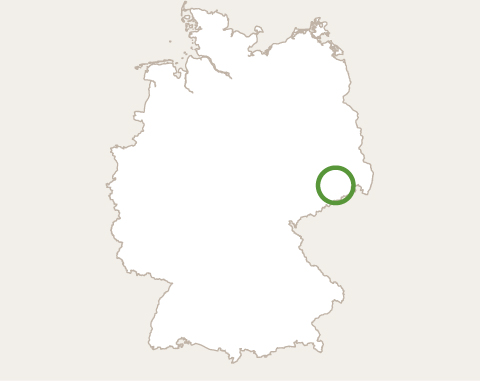
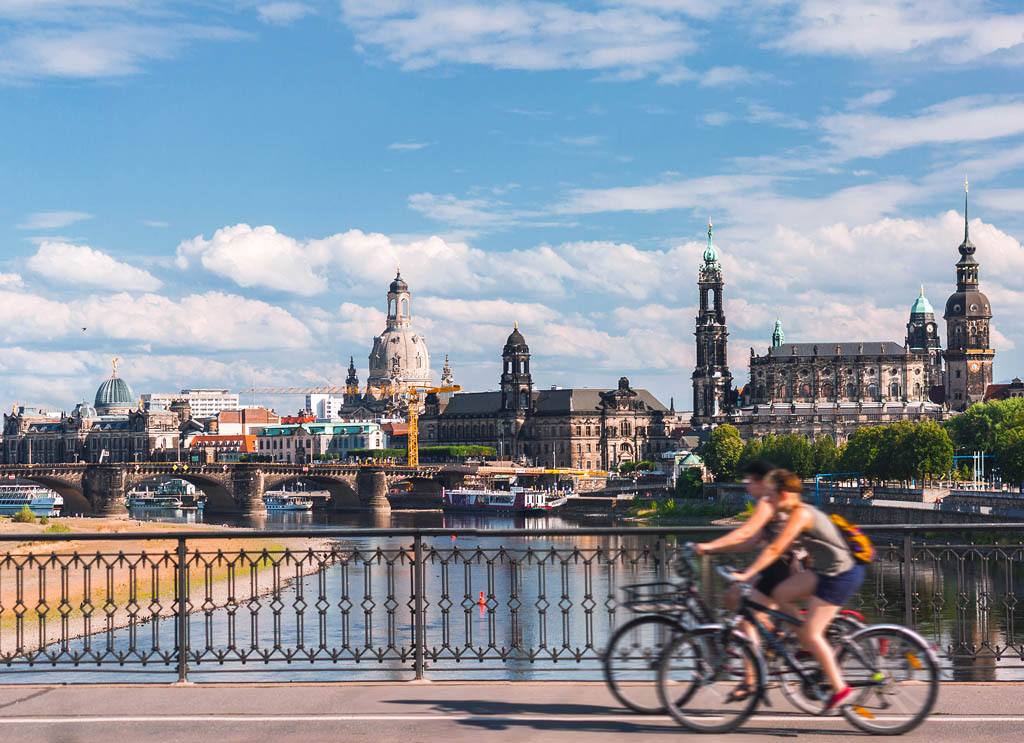
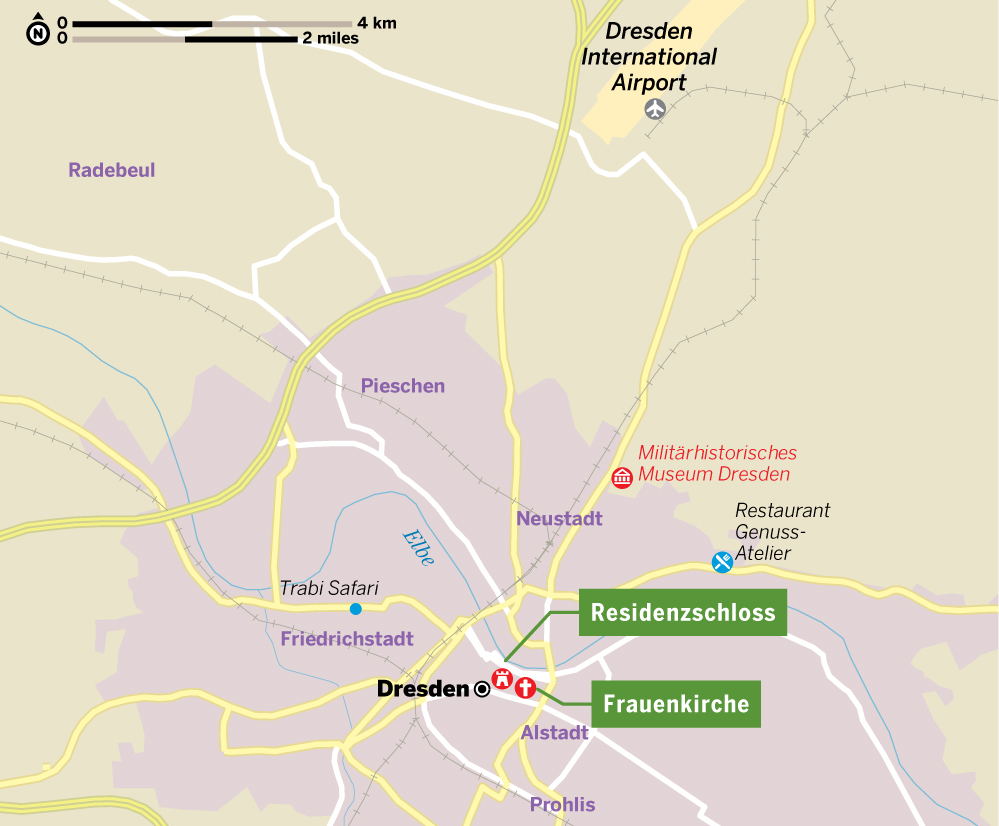
Dresden in One Day
Begin your explorations in the compact but magnificent baroque Altstadt, with your camera at the ready. Start the day with a wander through Augustus the Strong’s Zwinger palace, built out of Versailles envy. Allow at least a few hours to explore its superb museums. Next, follow your feet to the neo-Renaissance Semperoper then wander through the spectacular Residenzschloss which took over 50 years to rebuild from the WWII rubble.
Dresden in Two Days
On day two, round out your explorations of the Altstadt with a visit to the Frauen-kirche, the enduring symbol of the city, rebuilt from a rubble pile between 1994 and 2005, then head to the Albertinum gallery to sample fine art from the 18th century onwards. Cross the beautiful Augustusbrücke to the Innere Neustadt to experience a more down-to-earth side of the city, and round out your explorations with a visit to the Militärhistorisches Museum Dresden.
Arriving in Dresden
Dresden International Airport handles many domestic flights but only a handful of international connections.
Dresden Hauptbahnhof, to the south of the Altstadt, is served by national and regional trains.
Sleeping
Dresden’s centrally located hotels can be both bland and horrendously expensive, with rates among the highest in Germany. Thankfully there are plenty of cheap beds available at the city’s superb hostels. Given the efficient tram system, it’s also worth looking into cheaper – and often better – hotel options in outlying districts.
TOP EXPERIENCE
Frauenkirche
Dresden’s top sight, the unmissable Frauenkirche has become a symbol of East Germany’s post-communist renewal. Destroyed by Allied bombs in 1945, it was a heap of baroque rubble until rebuilding work began in 1994.
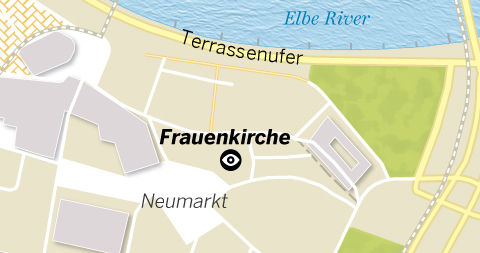
Great For…
 yDon’t Miss
yDon’t Miss
The altar, reassembled from nearly 2000 fragments, is especially striking.
 8Need to Know
8Need to Know
map Google map; ![]() %0351-6560 6100; www.frauenkirche-dresden.de; Neumarkt; audioguide €2.50, cupola adult/student €8/5;
%0351-6560 6100; www.frauenkirche-dresden.de; Neumarkt; audioguide €2.50, cupola adult/student €8/5; ![]() h10am-noon & 1-6pm Mon-Fri, weekend hours vary)
h10am-noon & 1-6pm Mon-Fri, weekend hours vary)
 5Take a Break
5Take a Break
The Frauenkirche is almost ringed with cafes that spill out onto the Neumarkt in summer.
 oTop Tip
oTop Tip
At the Visitors Centre you can watch a useful documentary about the church’s history.

Standing in perfect baroque wedding-cake symmetry on Dresden’s pretty Neumarkt, the domed Frauenkirche – Dresden’s most beloved symbol – returned to Dresden’s cityscape in 2005 after a decade of building work. The original had graced the skyline for two centuries, before collapsing after the WWII bombing raid which turned Dresden into an inferno and destroyed most of the city centre. It had been left as a war memorial – the East German authorities weren’t keen on rebuilding churches – but once the GDR’s regime had been swept away in 1989, plans for the churche’s comeback, which had been drawn up in 1985, were quickly accelerated.
Original Building
The original Frauenkirche dated back to the first half of the 18th century but a church had stood on this spot since the 11th century. The design you see today replaced a smaller building and was completed in 1743. Its most striking feature is the 96m-high dome, made of sandstone and weighing 12,000 tons. It was a remarkable feat of engineering for the time, comparable to the dome of St Paul’s in London. The rounded structure is a prominent feature on the Dresden skyline.
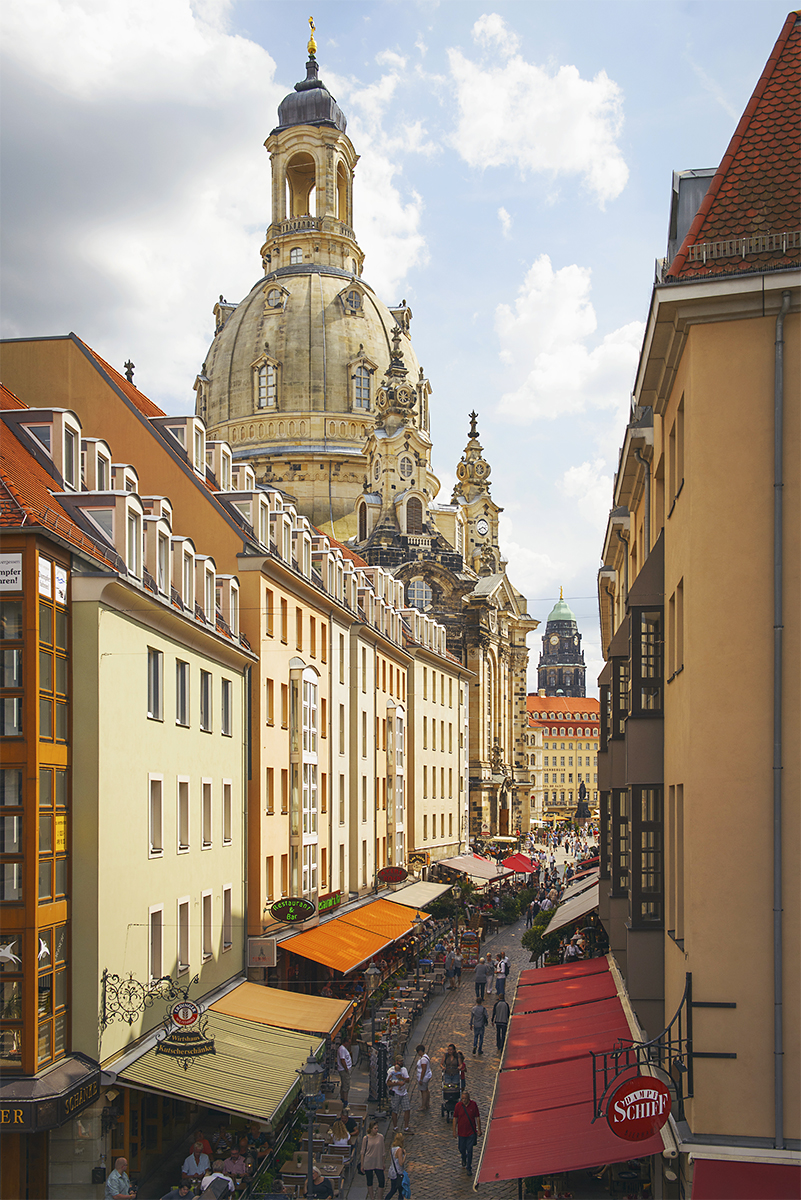
Destruction
Dresden city centre was (in)famously destroyed in a massive air raid launched by British and American planes on 13 February 1945. Some 3900 tons of explosives were hurled down on the city from over 1200 bombers. The resulting firestorm killed around 25,000 people and left Dresden a smouldering shell. The Frauenkirche stood throughout the two days of the raid until finally collapsing on 15 February.
Resurrection
The reconstruction work cost €180 million and was financed largely by donations raised by the Society to Promote the Reconstruction of the Church of Our Lady and Dresdner Bank. In a symbolic act of reconciliation, the cross and orb that tops the Frauenkirche were created by a British goldsmith whose father was involved in the February 1945 air raid.
A spitting image of the original, it may not bear the gravitas of age but that only slightly detracts from its festive beauty inside and out. The cupola can be climbed. The galleried interior is a wonderful place for concerts, meditations and services. Check the website (www.frauenkirche-dresden.de) for the current schedule or stop by the Frauenkirche Visitors Centre.
TOP EXPERIENCE
Residenzschloss
One of the highlights of any visit to Dresden, the Residenzschloss occupies a hefty chunk of the Altstadt. The residence of Saxony’s rulers for over 400 years, it’s now a treasure chest of the city’s art.
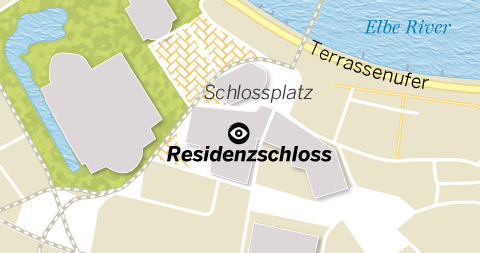
Great For…
 yDon’t Miss
yDon’t Miss
In the Historisches Grünes Gewölbe look out for the priceless Moor with Emerald Cluster.
 8Need to Know
8Need to Know
map; ![]() %0351-4914 2000; www.skd.museum; Schlossplatz; adult/child under 17yr €12/free, incl Historisches Grünes Gewölbe €21/free;
%0351-4914 2000; www.skd.museum; Schlossplatz; adult/child under 17yr €12/free, incl Historisches Grünes Gewölbe €21/free; ![]() h10am-6pm Wed-Mon)
h10am-6pm Wed-Mon)
 5Take a Break
5Take a Break
There are many cafes and restaurants in the streets and squares around the Residenzschloss.
 oTop Tip
oTop Tip
Buy timed tickets for the Historisches Grünes Gewölbe at www.skd.museum.

History
A fortress of some sort had stood on the site since the 13th century, but following a major fire a new baroque residence was commissioned in the early 18th century by Augustus II the Strong. This was then given a neo-Renaissance makeover in 1914, just in time for Saxony’s ruling dynasty to move out at the end of WWI. The palace suffered almost complete destruction in the American and British air raids of February 1945, after which the building was left as a pile of rubble. Some reconstruction began in the 1960s but it wasn’t until the end of the Cold War that serious efforts were made to bring the Residenzschloss back to life. Work wasn’t completed until 2013.
Dresden’s extraordinary city palace now houses multiple precious collections, including the unmissable Historisches Grünes Gewölbe (Green Vault), a real-life Aladdin’s Cave spilling over with precious objects wrought from gold, ivory, silver, diamonds and jewels. The entire renovated building, including its unique murals and baroque towers, is quite simply spectacular.

Collections
If you are intent on seeing everything at the Residenzschloss, you’ll need to set aside a whole day. There’s so much on display that two separate treasure chambers are needed to show off the extraordinary wealth of the Saxon rulers’ private collections. Established by Augustus II the Strong in 1723, the Historisches Grünes Gewölbe (map Google map; Historic Green Vault; €12) and the Neues Grünes Gewölbe (map Google map; New Green Vault; adult/child under 17yr incl audioguide €12/free) contain one of Europe’s largest treasure collections and the former was one of Europe’s first public museums. Sections in the Historisches Grünes Gewölbe are named after precious materials such as gold, silver, amber and ivory. Also housed here is the Kupferstich-Kabinett, which counts around half a million prints and drawings by 20,000 artists (including Dürer, Rembrandt, Michelangelo, Toulouse-Lautrec and Picasso) in its possession. Numismatists might want to drop by the Münzkabinett (Coin Cabinet) in the palace tower for a small array of historic coins and medals.
The Türckische Cammer (Turkish Chamber), one of the richest collections of Ottoman art outside Turkey, is also here. A huge three-mast tent made of gold and silk is one standout among many. The Riesensaal (Giant’s Hall) houses a spectacular 10,000-piece collection of armour, and the display includes recreations of jousting tournaments.

Dresden
1Sights
2Activities, Courses & Tours
1Sights
Key sights cluster in the compact Altstadt on the Elbe’s south bank, about 1km from the Hauptbahnhof via Prager Strasse, the main pedestrianised shopping strip. From here, Augustusbrücke leads across the river to the Neustadt, with its own major train station (Dresden-Neustadt) and the main pub and party quarter in the Äussere Neustadt (Outer Neustadt).
ZwingerPalace
(map Google map; ![]() %0351-4914 2000; www.der-dresdner-zwinger.de; Theaterplatz 1; ticket for all museums adult/concession €12/9, courtyard free;
%0351-4914 2000; www.der-dresdner-zwinger.de; Theaterplatz 1; ticket for all museums adult/concession €12/9, courtyard free; ![]() h6am-10pm Apr-Oct, to 8pm Nov-Mar)
h6am-10pm Apr-Oct, to 8pm Nov-Mar)
A collaboration between the architect Matthäus Pöppelmann and the sculptor Balthasar Permoser, the Zwinger was built between 1710 and 1728 on the orders of Augustus the Strong, who, having returned from seeing Louis XIV’s palace at Versailles, wanted something similar for himself. Originally a party palace for royals, the Zwinger has ornate portals that lead into the vast fountain-studded courtyard, which is framed by buildings lavishly festooned with evocative sculpture. Today it houses three superb museums within its baroque walls.
AlbertinumGallery
(map Google map; ![]() %0351-4914 2000; www.skd.museum; enter from Brühlsche Terrasse or Georg-Treu-Platz 2; adult/concession/child under 17yr €10/7.50/free;
%0351-4914 2000; www.skd.museum; enter from Brühlsche Terrasse or Georg-Treu-Platz 2; adult/concession/child under 17yr €10/7.50/free; ![]() h10am-6pm Tue-Sun)
h10am-6pm Tue-Sun)
The Renaissance-era former arsenal is the stunning home of the Galerie Neue Meister (New Masters Gallery), which displays an array of paintings by some of the great names in art from the 18th century onwards. Caspar David Friedrich and Claude Monet’s landscapes compete with the abstract visions of Marc Chagall and Gerhard Richter, all in gorgeous rooms orbiting a light-filled courtyard. There’s also a superb sculpture collection spread over the lower floors.
Militärhistorisches Museum DresdenMuseum
(![]() %0351-823 2803; www.mhmbw.de; Olbrichtplatz 2; adult/concession €5/3;
%0351-823 2803; www.mhmbw.de; Olbrichtplatz 2; adult/concession €5/3; ![]() h10am-6pm Thu-Sun & Tue, to 9pm Mon;
h10am-6pm Thu-Sun & Tue, to 9pm Mon; ![]() j7 or 8 to Stauffenbergallee)
j7 or 8 to Stauffenbergallee)
Even devout pacifists will be awed by this engaging museum, housed in a 19th-century arsenal bisected by a bold glass-and-steel wedge designed by Daniel Libeskind. Exhibits have been updated for the 21st century, so don’t expect a rollcall of military victories or a parade of weapons. Instead, you’ll find a progressive – and often artistic – look at the roots and ramifications of war and aggression.
SemperoperHistoric Building, Opera
(map Google map; ![]() %0351-320 7360; www.semperoper-erleben.de; Theaterplatz 2; tour adult/concession €11/7;
%0351-320 7360; www.semperoper-erleben.de; Theaterplatz 2; tour adult/concession €11/7; ![]() hhours vary)
hhours vary)
One of Germany’s most famous opera houses, the Semperoper opened in 1841 and has hosted premieres of famous works by Richard Strauss, Carl Maria von Weber and Richard Wagner. Guided 45-minute tours operate almost daily (the 3pm tour is in English); exact times depend on rehearsal and performance schedules. Buy advance tickets online to skip the queue.

TTours
Trabi SafariDriving
(![]() %0351-8990 0110; www.trabi-safari.de; Bremer Strasse 35; adult/child under 17 €49/free)
%0351-8990 0110; www.trabi-safari.de; Bremer Strasse 35; adult/child under 17 €49/free)
Get behind the wheel of the ultimate GDR-mobile for this 1½-hour guided drive around the city, taking in sights from all eras. The price depends on the number of people in the car; four people to a car is the best value.
NightWalk DresdenWalking
(map Google map; ![]() %0172 781 5007; www.nightwalk-dresden.de; Albertplatz; €17;
%0172 781 5007; www.nightwalk-dresden.de; Albertplatz; €17; ![]() h9pm)
h9pm)
See street art, learn what life was like in East Germany and visit fun pubs and bars in the Outer Neustadt on this superfun tour. NightWalk also has the exclusive rights to take visitors to the slaughterhouse where Kurt Vonnegut Jr survived the bombing of Dresden in 1945, and which he later immortalised in Slaughterhouse-Five.
Dresden & WWII
Between 13 and 15 February 1945, British and American planes unleashed 3900 tonnes of explosives on Dresden in four huge air raids. Bombs and incendiary shells whipped up a mammoth firestorm, and ashes rained down on villages 35km away. When the blazes had died down and the dust settled, tens of thousands of Dresdners had lost their lives and 20 sq km of this once-elegant baroque city lay in smouldering ruins.
Historians still argue over whether this constituted a war crime committed by the Allies on an innocent civilian population. Some claim that with the Red Army at the gates of Berlin, the war was effectively won, and the Allies gained little military advantage from the destruction of Dresden. Others have said that, as the last urban centre in the east of the country left intact, Dresden could have provided shelter for German troops returning from the east and was a viable target.
Sächsische DampfschiffahrtBoating
(map Google map; ![]() %0351-866 090; www.saechsiche-dampfschiffahrt.de; Terrassenufer; adult/concession €18.50/11)
%0351-866 090; www.saechsiche-dampfschiffahrt.de; Terrassenufer; adult/concession €18.50/11)
Ninety-minute Elbe tours leave from the Terrassenufer dock several times daily in summer, aboard the world’s oldest fleet of paddle-wheel steamers. There are also services to Saxon Switzerland and castles along the river.
Grosse StadtrundfahrtBus
(map Google map; ![]() %0351-899 5650; www.stadtrundfahrt.com; Theaterplatz; day pass adult/concession €20/18;
%0351-899 5650; www.stadtrundfahrt.com; Theaterplatz; day pass adult/concession €20/18; ![]() h9.30am-10pm Apr-Oct, to 8pm Nov-Mar)
h9.30am-10pm Apr-Oct, to 8pm Nov-Mar)
This narrated hop-on, hop-off tour, with 22 stops and optional short guided tours, ticks off all the major sights. Buses leave every 15 to 30 minutes.
Peeking Behind the Iron Curtain
Pirna is a charming town on the Elbe, famous as Canaletto’s home during his years in Saxony, and a friendly and easy-going place today. The big attraction in town is the excellent DDR Museum (![]() %03501-774 842; www.ddr-museum-pirna.de; Rottwerndorferstrasse 45; adult/child €8/6;
%03501-774 842; www.ddr-museum-pirna.de; Rottwerndorferstrasse 45; adult/child €8/6; ![]() h10am-5pm Tue-Sun Apr-Oct, 10am-5pm Tue-Thu, Sat & Sun Nov-Mar; entry after 3.30pm), in a former army barracks on the outskirts of the town. You can wander around a fully furnished East German apartment, sit in a classroom with GDR president Walter Ulbricht glowering at you, or find out how much a Junge Pioniere youth organisation uniform cost.
h10am-5pm Tue-Sun Apr-Oct, 10am-5pm Tue-Thu, Sat & Sun Nov-Mar; entry after 3.30pm), in a former army barracks on the outskirts of the town. You can wander around a fully furnished East German apartment, sit in a classroom with GDR president Walter Ulbricht glowering at you, or find out how much a Junge Pioniere youth organisation uniform cost.
To get here, take the S1 from Dresden’s Hauptbahnhof to Pirna, walk five minutes to the central bus station (ZOB) and hop on local bus N for ‘Geibeltbad/Freizeitzentrum’ (€4, 35 minutes).

5Eating
Little IndiaIndian€€
(map Google map; ![]() %0351-3232 6400; www.littleindia-dresden.de; Louisenstrasse 48; mains €10-15;
%0351-3232 6400; www.littleindia-dresden.de; Louisenstrasse 48; mains €10-15; ![]() h11am-2.30pm & 5-11pm Tue-Sat, to 10pm Sun;
h11am-2.30pm & 5-11pm Tue-Sat, to 10pm Sun; ![]() v)
v)
Bright, minimalist and informal, this fantastic Indian restaurant is a world away from most in Dresden, and its popularity is obvious (be prepared to wait for a table when it’s busy). The large menu (available in English) includes superb tandoori dishes and an entire vegetarian section, as well as standard chicken, lamb and pork mains. The naan is heavenly.
Cafe ContinentalInternational€€
(map Google map; ![]() %0351-272 1722; www.cafe-continental-dresden.de; Görlitzer Strasse 1; dishes €6-20;
%0351-272 1722; www.cafe-continental-dresden.de; Görlitzer Strasse 1; dishes €6-20; ![]() h9am-1am Sun-Thu, to 3am Fri & Sat;
h9am-1am Sun-Thu, to 3am Fri & Sat; ![]() W)
W)
If the greenly lit openings behind the bar remind you of aquariums, you’ve hit the nail on the head, for buzzy ‘Conti’ was a pet store back in GDR days. Today, it’s a great place to hit no matter the hour, for anything from cappuccino or cocktails to homemade cakes or a full meal.
RaskolnikoffInternational€€
(map Google map; ![]() %0351-804 5706; www.raskolnikoff.de; Böhmische Strasse 34; mains €10-15;
%0351-804 5706; www.raskolnikoff.de; Böhmische Strasse 34; mains €10-15; ![]() h11am-10.30pm Mon-Sat, from 9am Sun)
h11am-10.30pm Mon-Sat, from 9am Sun)
An artist squat in the 1980s, Raskolnikoff now brims with grown-up artsy-bohemian flair, especially in the sweet little garden at the back, complete with a bizarre water feature. The seasonally calibrated menu showcases the fruits of the surrounding land in globally inspired dishes, including a variety of pelmeni (Russian dumplings), which proudly represent the Dostoyevsky character the establishment is named after.
SophienkellerSaxon€€
(map Google map; ![]() %0351-497 260; www.sophienkeller-dresden.de; Taschenberg 3; mains €12-20;
%0351-497 260; www.sophienkeller-dresden.de; Taschenberg 3; mains €12-20; ![]() h11am-1am)
h11am-1am)
The 1730s theme, complete with waitresses trussed up in period garb, may be a bit overcooked, but the local specialities certainly aren’t. It’s mostly rib-sticking fare, such as the boneless half-duck with red cabbage or the spit-roasted suckling pig. Wash it down with a mug of dark Bohemian Krušovice, and enjoy the ambience of vaulted ceilings in the Taschenbergpalais building.
Restaurant Genuss-AtelierGerman€€€
(![]() %0351-2502 8337; www.genuss-atelier.net; Bautzner Strasse 149; mains €15-27;
%0351-2502 8337; www.genuss-atelier.net; Bautzner Strasse 149; mains €15-27; ![]() h5-11pm Wed-Fri, noon-3.30pm & 5-11pm Sat & Sun;
h5-11pm Wed-Fri, noon-3.30pm & 5-11pm Sat & Sun; ![]() j11 to Waldschlösschen)
j11 to Waldschlösschen)
Lighting up Dresden’s culinary scene is this fantastic place that’s well worth the trip on the 11 tram. The creative menu is streets ahead of most offerings elsewhere, although the best way to experience the ‘Pleasure-Atelier’ is to book a surprise menu (three/four/five courses €39/49/59) and let the chefs show off their craft. Reservations essential.

6Drinking & Nightlife
Every other door leads into a bar in the centre of Outer Neustandt, at the crossing of Görlitzer Strasse and Louisenstrasse. Some people just plonk themselves down on the pavement and drink in big seated groups…who needs bars?
Bottoms UpBar
(map Google map; ![]() %0351-802 0158; Martin-Luther-Strasse 31;
%0351-802 0158; Martin-Luther-Strasse 31; ![]() h5pm-5am Mon-Fri, from 10am Sat & Sun)
h5pm-5am Mon-Fri, from 10am Sat & Sun)
This is one of Neustadt’s most popular and happening bars. There’s an outside beer garden, cider on tap, choices of beers ranging from fancy Belgian to local German, and a cosy interior that gets packed at night. The weekend brunch is excellent.
LouisengartenBeer Garden
(map Google map; www.biergarten-dresden.de; Louisenstrasse 43; ![]() h4pm-1am Sun-Thu, 3pm-2am Fri & Sat)
h4pm-1am Sun-Thu, 3pm-2am Fri & Sat)
This boho-flavoured beer garden takes the go-local concept to the limit. Wind down the day with beer (Lenin’s Hanf, aka Lenin’s Hemp) supplied by the nearby Neustädter Hausbrauerei and grilled meats courtesy of the butcher down the street.
Lloyd’sBar
(map Google map; ![]() %0351-501 8775; www.lloyds-cafe-bar.de; Martin-Luther-Strasse 17;
%0351-501 8775; www.lloyds-cafe-bar.de; Martin-Luther-Strasse 17; ![]() h8am-1am)
h8am-1am)
In a quiet corner of the Neustadt, Lloyd’s oozes grown-up flair thanks to stylish cream-coloured leather furniture, huge mirrors and fanciful chandeliers. It’s a solid pit stop from breakfast to that last expertly poured cocktail; it even does a respectable afternoon tea and cake by the fireplace.
DowntownClub
(map Google map; ![]() %0351-811 5592; www.downtown-dresden.de; Katharinenstrasse 11-13;
%0351-811 5592; www.downtown-dresden.de; Katharinenstrasse 11-13; ![]() h10pm-late Fri & Sat)
h10pm-late Fri & Sat)
This iconic old factory is home to one of Dresden’s most popular clubs, a mainstream affair that packs in a young and up-for-it crowd with three floors of dance action. There’s a main floor with hits of the ’80s and ’90s (you have been warned), an electro lounge and a loft floor with R’n’B sounds.
8INFORMATION
The excellent Dresden Card (www.dresden.de/dresdencard) provides free public transport as well as sweeping sightseeing discounts. Various cards are available from the Tourist Office (map; ![]() %0351-501 501; www.dresden.de; QF Passage, Neumarkt 2;
%0351-501 501; www.dresden.de; QF Passage, Neumarkt 2; ![]() h10am-7pm Mon-Fri, to 6pm Sat, to 3pm Sun). The one-day Dresden-City-Card (single/family €12/15) is good for transport and discounts to 90 sights, attractions, tours and other participating venues. The two-day version (€37/66) delivers free admission to all state museums with the exception of the Historisches Grünes Gewölbe, and discounts on many others. The Dresden-Regio-Card (from €20/30) includes all this plus discounts to 40 additional sights. All in all, they’re excellent value and guarantee big savings if you plan to visit several museums in Dresden.
h10am-7pm Mon-Fri, to 6pm Sat, to 3pm Sun). The one-day Dresden-City-Card (single/family €12/15) is good for transport and discounts to 90 sights, attractions, tours and other participating venues. The two-day version (€37/66) delivers free admission to all state museums with the exception of the Historisches Grünes Gewölbe, and discounts on many others. The Dresden-Regio-Card (from €20/30) includes all this plus discounts to 40 additional sights. All in all, they’re excellent value and guarantee big savings if you plan to visit several museums in Dresden.
8GETTING THERE & AWAY
AIR
Dresden International Airport (DRS; ![]() %0351-881 3360; www.dresden-airport.de; Flughafenstrasse) has flights to many German cities and international destinations including Amsterdam, Zurich, Dubai and Moscow.
%0351-881 3360; www.dresden-airport.de; Flughafenstrasse) has flights to many German cities and international destinations including Amsterdam, Zurich, Dubai and Moscow.
The S2 train links the airport with the city centre several times hourly (€2.30, 20 minutes). Taxis are about €20.
TRAIN
Fast trains make the trip to Dresden from Berlin-Hauptbahnhof in two hours (€40) and Leipzig in 1¼ hours (€19.90). The S1 local train runs half-hourly to Meissen (€6.20, 40 minutes) and Bad Schandau in Saxon Switzerland (€6.20, 45 minutes). RE trains connect Dresden with Chemnitz (€16, one hour) via Freiberg (€9.70, 30 to 45 minutes).
8GETTING AROUND
Buses and trams are run by Dresdner Verkehrsbetriebe (DVB; map; ![]() %0351-857 1011; www.dvb.de/en). Fares within town cost €2.30, and a day pass €6, valid until 4am the following morning. Buy tickets from vending machines at stops or aboard trams, and remember to validate them in the machines provided.
%0351-857 1011; www.dvb.de/en). Fares within town cost €2.30, and a day pass €6, valid until 4am the following morning. Buy tickets from vending machines at stops or aboard trams, and remember to validate them in the machines provided.